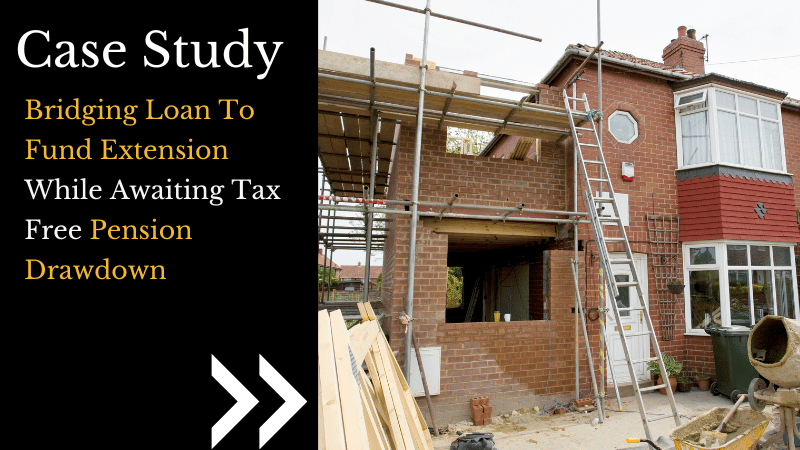While options like a remortgage or a second-charge mortgage can be used to fund home improvements, they come with longer application times and strict affordability checks. A bridging loan is a short-term, specialist product designed to overcome these hurdles, making it the ideal solution in many extension scenarios.
Consider using bridging finance for your extension if:
- You need funding quickly: A bridging loan can be arranged in as little as 5-7 working days, which is crucial if you need to pay contractors or purchase materials without delay.
- Your project is extensive: Major works like large extensions are classed as "heavy refurbishment." Many high-street mortgage lenders are unwilling to lend for such projects until the work is complete, whereas bridging lenders specialise in this area.
- You are in the middle of a fixed-rate mortgage: Remortgaging could trigger substantial Early Repayment Charges (ERCs). A bridging loan can provide the funds you need without disturbing your favourable mortgage deal.
- You have a complex income structure: Bridging finance focuses on the property's value and your exit plan, not your income history. This is ideal for self-employed individuals or those with irregular earnings who may struggle with standard affordability tests.
- You are waiting on other funds: If you plan to pay for the extension with an upcoming inheritance, bonus, or pension drawdown, a bridging loan can "bridge the gap," allowing you to start work immediately.
The Process: Funding Your Extension with a Bridging Loan
Securing bridging finance for an extension is a structured process designed for efficiency. With a broker like Clifton Private Finance, the journey is straightforward:

Initial Planning & Consultation
You'll discuss your extension plans, budget, property value, and existing mortgage details with one of our specialist advisors. We will help you outline a clear plan and a viable exit strategy.

Application & Lender Matching
We package your application, highlighting its strengths, and present it to the most suitable lenders from our network—those who understand heavy refurbishment projects and offer competitive terms.

Valuation & Formal Offer
The lender will arrange a valuation of your property to confirm its current value and sometimes its projected value post-extension. Once satisfied, they will issue a formal loan offer.

Funds Released & Construction Begins
After legal checks are complete, the funds are released, allowing you to commence or continue your extension project without financial holds-ups.

Executing the Exit Strategy
As the project nears completion, we will help you action your exit plan—typically refinancing your property onto a new mortgage—to repay the bridging loan.
Key Criteria for an Extension Bridging Loan
Unlike a standard mortgage application, bridging lenders prioritise two core elements:
- Security: The loan is secured against the equity in your property. Lenders will assess the current market value of your home and the value of your outstanding mortgage to determine the available equity. The higher your available equity, the lower the risk and the more you can potentially borrow.
- A Credible Exit Strategy: This is the most critical part of the application. You must have a clear, realistic plan for how you will repay the bridging loan in full at the end of its term. The strength of your exit strategy directly influences a lender's willingness to approve the loan.
Because the focus is on security and exit, factors like your credit score and monthly income, while still considered, are less critical than in a mortgage application.
Common Exit Strategies for Extension Bridging Loans
For a home extension project, the exit strategy is almost always a remortgage.
Understanding Loan Amounts, Rates, and Terms
At Clifton Private Finance, we can arrange bespoke bridging finance tailored to your extension project:
- Loan Amounts: From £50,000 up to £25m, depending on the scale of your project and available equity.
- Loan-to-Value (LTV): Typically up to 80% of your property's value. In some cases, this can be higher if additional assets are used as security.
- Interest Rates: Competitive market rates from 0.55% per month, with lower rates often available for loans over £1 million.
- Interest Roll-Up: A key feature where you make no monthly interest payments. Instead, the interest is "rolled up" and paid in one go with the capital loan when you exit. This frees up your cash flow to focus entirely on the extension project.
- Loan Term: Flexible terms from 3 months up to 36 months, providing ample time to complete the work and arrange your remortgage.
The Clifton Private Finance Advantage for Extension Funding
Navigating the specialist lending market for extension finance requires experience and established relationships. High-street banks rarely offer suitable products for significant renovation projects, which is why a specialist broker is essential.
Partnering with Clifton Private Finance means you have an expert team dedicated to securing the best possible funding package. We have strong links to private banks and specialist lenders who not only understand heavy refurbishment projects but also welcome applications from clients with complex needs. We handle the entire process, from initial planning to securing the funds and structuring the exit, ensuring your extension project is built on solid financial foundations.
If you're planning an extension and need a fast, flexible funding solution, contact our team of bridging specialists today.












